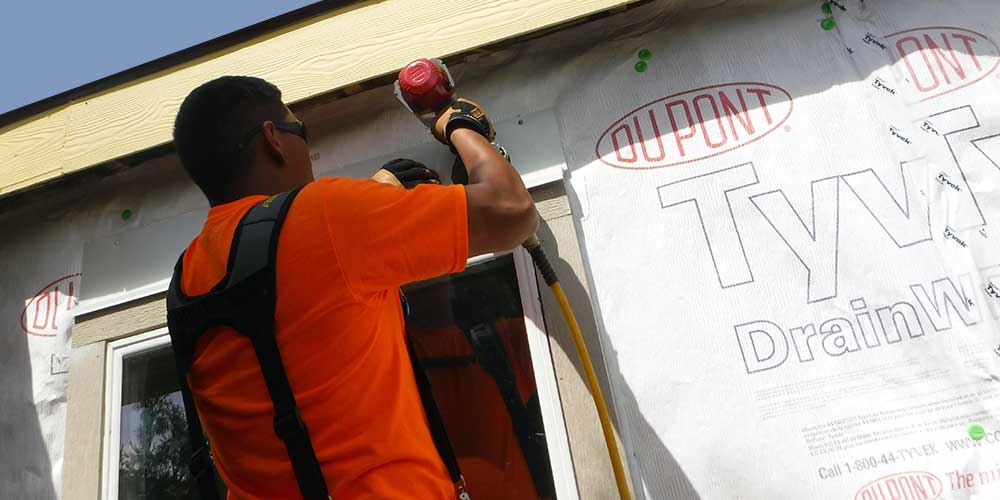4 MIN READ
Window Leak
DIY For The Short-Term, SFW For The Long-Term
A window leak is the most common entry point for water finding its way into your home. Others include your roof, chimney chase, skylights, and doors. This is one of the last things any homeowner wants to see. It’s irritating and causes frustration. Additionally, you have to figure out how to fix the dripping sound and stop pools of water from piling up inside your home. After years of providing leak repair services, we’ve narrowed it down to three common mistakes that homeowners make that get them in way over their heads when repairing leaking windows. While you may be able to repair window leaks yourself—it will probably only be a temporary fix. This is fine, as long as you have a professional window and siding contractor come in and fix it later.
Window Leak Due To Missing or Incorrect Installation Of Weather Resistant Barrier
A weather-resistant barrier (WRB) is one of the critical materials you need to protect your home from the elements we see here in the Pacific Northwest. WRB is a part of the exterior wall system which protects the building materials from water penetration. The barrier performs like a shell for water that has penetrated the exterior siding. The water won’t pass through to the house’s wood because of the shell WRB provides to make the water vapor escape. The material we use is best in its class, DuPont Tyvek. The material is durable, permeable, and easy to install—if done correctly. This strong weather-resistant barrier will ensure the structural integrity of your home by making it air and moisture-resistant between your siding and your sheathing, as well as all openings, like windows and doors. Even though installing or fixing WRB is fairly straightforward, doing it properly requires the removal of your siding around the window opening, thereby making it a more complicated job. Most DIY homeowners should not attempt this unless they have prior experience working with building envelopes. And, unfortunately, this might be the cause of your window leak.
Window Leak Due To Incorrect Installation Of Flashing Around Windows
Each part of your building envelope system plays a vital role in the constant deflection of moisture, whether excessive humidity, pelting rain, ice, or snow. Due to the drastic weather changes, the quality of materials along with the installation method matters. The proper integration of each part of the system is crucial, so it can work together as one unit to protect your home. Which makes the flashing another crucial piece of the puzzle. Flashing is a thin metal sheet made from metal such as aluminum, stainless steel, copper, plastic, and more. The flashing goes around areas that may be vulnerable to leaks, such as skylights, chimney chases, doors, and windows. When installed correctly, along with other components, openings to your home are protected, and the flashing will re-route water away from—eliminating potential leak intrusion. Incorrect installation of the flashing component or lack of window flashing altogether is the most common cause of window leaks we see in the Pacific Northwest. Like your home’s WRB, window flashing is fairly easy to work with, but it works together with your WRB and siding to protect the home from leaks. Therefore, even if you determine you have a window flashing issue, you’ll soon be knee-deep in a bigger repair as it is one component of a system that seals your home from the elements.
Window Leak Due To Using “The Wrong” Caulking
The first thing homeowners think of when tackling window leaks is caulking. Find the leak, apply some caulking, issue solved. Simple right? Not so fast… not all caulking is created equally. If your caulking has failed, chances are it failed because it’s no longer at or above industry standards, or it was just cheap, to begin with. We use and recommend MasterSeal NP 1 caulking. It is more expensive, but it’s worth it.
However, even though it is one of the most durable caulking products on the market, it still won’t provide you the solution you need. Using caulking to fix an active window leak is like putting a band-aid on a severe wound; it just doesn’t work. You have to find the issue and a long-term solution if you don’t want the leak to come back. This takes some investigative work into the root cause of your leak.
Commonly, we see construction defects when working on homes due to poor craftsmanship, faulty design, inferior materials, and carelessness due to work overload. Issues may also occur because the sealant is not appropriately applied, joined improperly, or not nailed sufficiently. These issues are prevalent in more contemporary homes because they just weren’t built to industry standards.
DIY For The Short-Term, SFW For The Long-Term
Active window leaks don’t stop because they usually involve some underlying issue regarding the products used and/or craftsmanship of your home. We encourage you to stop making the same mistakes other homeowners make by looking for the “cheapest” solution. It will most likely be a short-term one that will fail. Tarping and temporary caulking are both suitable solutions for the average homeowner to do in the short-term. However, you should look for a long-term solution by hiring a reputable siding contractor to provide you with a solution that will last. SFW Construction has provided homeowners with long-term window leak repairs, siding repairs, and dry rot solutions across The Pacific Northwest since 2005. We only use best-of-breed products and employ the most experienced carpenters who are experts in their trades.


